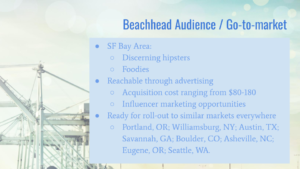
Direct-to-consumer customizable eyeglasses company Pair eyeglasses acquired $75 million in fresh Series C funding to advance its automated U.S. production technologies and broaden its global client base.
With over 1,000 “top frame” options—from iconic television shows and movies to painters like Van Gogh and Frida Kahlo—the company makes it easy for adults and kids who wear glasses to modify their appearance. Prescription lens prices for glasses start at $60 per pair, and they include a digital experience. The starting price for top frames is $25.
The New York-based startup recently updated us a minute ago. They previously raised $12 million and $60 million in investment rounds in 2021.
Pair Eyewear co-CEO and co-founder Sophia Edelstein told TechCrunch that the company was refocusing on adults and social media after the launch of its funding round in December 2021. These methods have proven successful.
After then, Edelstein added, “we’ve continued to grow exponentially here in the United States, mainly as an adult brand.” We sell over 3 million top brands here in the United States and Canada by the end of this year, and over 95% of our consumers today are adults making purchases for themselves. Furthermore, we take great pride in the fact that our customer base closely reflects the US Census. Our guiding principle is to attempt and deliver an accessible, reasonably priced, and customized service to consumers.
In particular, the company’s revenue increased by 24 times between 2020 and 2023, and by the end of this year, it is anticipated to have doubled from the previous year. Of those, TikTok generates millions in income and more than 25% of the brand’s overall revenues.
To accommodate a larger range of head sizes, the business also introduced a wider base frame line in the last year. Additionally, Pair Eyewear transformed into a vertically integrated manufacturing plant in September, producing all of its top frames and lenses internally. According to Edelstein, the 40,000-square-foot facility in California is “the most automated lens lab in the United States.” Soon, a second facility will be operational.
NFL athlete Christian McCaffrey, Javelin Venture Partners, and current investors New Enterprise Associates and Prysm Capital joined the investment round.
Although Edelstein declined to provide the company’s valuation, she did reveal that it has increased significantly since the previous financing. With this latest investment, Pair Eyewear has received $145 million in venture capital funding overall.
Edelstein called this “an opportunistic round.” In current economic climate, which has been difficult for consumer industries, investors were drawn to the business model, strong margins, and growth strategy of the company, she continued.
Co-founder and partner at Prysm Capital Matt Roberts confirmed this opinion in a written statement, saying, “Pair is loved by its customers with a differentiated and customizable product, an ecosystem of brand partnerships, and a focus on community.” We are excited to work with the team as they pursue their expansion, as the company’s ongoing innovation and investment in automation technology have further strengthened their capacity to seize the growth potential that lies ahead.
The increased money will be used by Edelstein to expand its product line and the lens lab, as well as to purchase further automation technologies. Additionally, the business is considering omnichannel distribution, which would introduce Pair Eyewear into a store environment.
“We genuinely believe in onshore manufacturing and we adore the concept of ‘Made in the U.S.'” stated Edelstein. Furthermore, we are also focused on expanding internationally. Our goal for the business is to become a worldwide leader in eyeglasses. People all throughout the world are drawn to the desire of individuals to express who they are and what makes them unique.
You must have a killer GTM slide if you plan to market.

Merely 7% of entrepreneurs possess a pitch deck that features a passably strong go-to-market (GTM) story. Let me explain what I mean by raising money to attract new clients, as many founders are doing this: It’s utterly embarrassing.
Most PowerPoint decks are hardly even close to being considered coherent brainstorms. As an investor, I become depressed when I see a deck like that. Given that you blatantly lack any idea about how you’re going to use my $5 million, why should I give you any?
Believe me when I tell that fundraising is difficult at the moment and does not appear to be getting any easier. Possessing a fundamental level of competency is essential.
Here’s how you go about creating a strong go-to-market slide:
Having a thorough understanding of your target audience is essential to creating a compelling slide and successful go-to-market plan. To fully understand the demands, challenges, and decision-making processes of your potential users, you must immerse yourself in their lives beyond simple demographic categorization. This calls for diligence, compassion, and well-thought-out market research. The GTM slide frequently doesn’t make sense without your understanding of your customers, which frequently appears elsewhere in the deck (under “target customer” or something similar).
It is your responsibility to analyze and find trends in their needs, interests, and behaviors after you have your data. For example, if you are releasing a new fitness software, you may discover that many users prefer individualized training schedules. Such knowledge is essential for tailoring your GTM plan to the particular requirements of your target market. In turn, this personalization informs the channels you want to use for product marketing.
This information can be included in the appendix, but it helps with market segmentation. Because consumer segments vary, your GTM plan may need to take different tactics for each one. For instance, even though both baby boomers and tech-savvy millennials could benefit from your offering, contacting them may call for a different approach than engaging tech-savvy millennials.
Combining all of this will produce an evidence-based go-to-market narrative that is far stronger. It will also demonstrate your experimentation and baseline, which you may hopefully raise with time.
GTM tying in with your expenses
In actuality, an inventive product is merely the beginning. The majority of entrepreneurs overestimate that aspect. Sure, it’s crucial, but actually getting in front of your target audience is the main obstacle. This is where your plan for acquiring new customers comes into play. How are you going to draw in new customers and users to your product or service? In order to cultivate client loyalty, startups must truly engage their customers. Your GTM strategy should include a cost-effective and scalable approach to attracting, engaging, and converting prospects.
This is all quite vague so far. When creating the execution plan, that’s when the real work is done. Which media outlets are you going to use? How much will it cost? What is your overall CAC per customer across all channels (commonly referred to as “blended CAC”) and what is your custom acquisition cost (CAC) per channel? You’ll appear as a founder who has a very clear idea of where they need to go and where they are right now if you have all those numbers in order.

Even though organic reach is important, sponsored advertising can help you get more done, especially in the beginning. You can use platforms like Google Ads and Facebook Ads to target advertising to particular demographic groups. Making advertising that appeal to your target market and optimizing campaigns for maximum return on investment are crucial.
After that, you’ll need to continuously modify your plan in light of feedback and statistics. Finding the ideal strategy for your audience might be aided by A/B testing various techniques. You may improve the efficacy and efficiency of your plan and establish objectives based on it by being willing to try new things. The comment, “We think we can optimize that to $240 per customer, but right now we’re acquiring customers at $390,” is impactful. Provide some data to support your theory, and all of a sudden you have a really interesting story to tell.
CAC is more than just a figure; it’s a tool for assessing how well your client acquisition plan is working. It must to be taken into account in conjunction with a customer’s Lifetime Value (LTV), which ought to greatly surpass CAC in order to be a feasible, scalable business strategy. One crucial statistic is the ratio of CAC to LTV. Assess it, document it, and compare it to the sector.
Market expansions
Reaching out to new markets or niches is a common part of growth. This could entail broadening your product line, focusing on a different customer segment, or targeting a new geographic location. In-depth market research is necessary for each of these methods in order to recognize opportunities and comprehend the particular difficulties they provide. For example, expanding geographically may require negotiating new legal frameworks or subtle cultural differences.
To properly customize your approach to each new market, it is imperative to have a clear grasp of these aspects. For example, if part of your GTM is “Launch in Germany,” but you have only operated in the U.S. up to this point, you must demonstrate how dangerous this method is. Are you able to access the appropriate channels? Are you familiar with the market? What dangers come with using this strategy? And if it does work, what are the benefits?
It is a well-established fact that any type of expansion requires human capital, and your staff is your most significant asset when it comes to growing. Attracting, keeping, and growing talent becomes more crucial as you expand. This entails cultivating a culture that encourages creativity, agility, and ongoing learning in addition to selecting people with the appropriate abilities and mindset. Are the appropriate people in the right positions to lead and maintain success in your company? Fantastic! Include that in the story as well.
metrics for victory
So how do you know if what you’re doing is working? You measure it. Metrics are a cornerstone of marketing, and your investors will want to see that your plan is aggressive, but achievable.
Crafting financial projections requires balancing optimism with realism. Estimate your revenue for a future period (monthly, quarterly or yearly) based on market size, pricing, sales efforts and capacity. If you want to go all-out, model it so and include best-case, worst-case and likely scenarios to navigate market conditions in an appendix slide.

However, for the core deck, demonstrating your understanding of the financial levers driving your growth can be aided by having a clear grasp of your life-time value, gross margin, customer acquisition cost, and monthly or annual recurring revenue (MRR/ARR).
Locating the story
Your go-to-market plan involves a lot of moving parts, and the core deck doesn’t need to contain every aspect of the narrative. Strong go-to-market strategies are only included in some of the best pitch decks I’ve seen, and they target the beachhead audience—the initial client profile you want to target. They go on to list further strategies in the appendix, but that serves to demonstrate that you have a strong, carefully considered Plan A for client acquisition. Combining all of those factors makes it easier for an investor to defend their interest in writing a check.